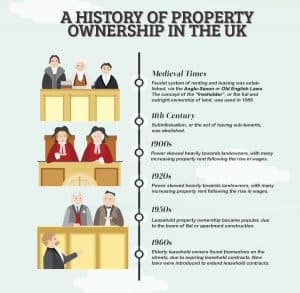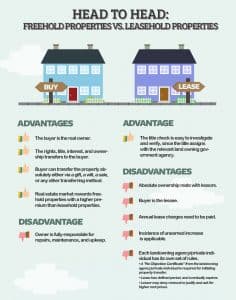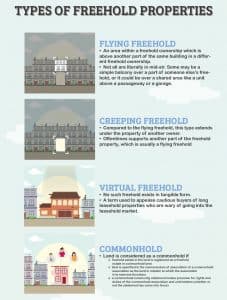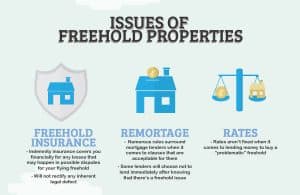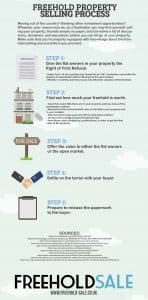Infographics: All You Need to Know About Freehold Properties

There was once a time when the housing market was something of a volatile one. However, the modern world of freehold properties is now something of a lively one, and this can be attributed to the quick exchanges that buyers and sellers experience, as well as the rising value of the market as a whole. As such, it can be tempting to jump on board and enjoy the benefits that owning a freehold property can bring, but to do so, we must understand how the freehold property process works.
The History of Property Ownership
Of course, owning a property in the modern age is very different when compared to the housing market of yesteryear. During the medieval times, the feudal system of how renting and leasing should be carried out was introduced. The terminology ‘freeholder’ was first introduced in 1089. During the 11th century, subinfeudation was abolished, also known as the act of having sub-tenants. The early 20th century saw the popularity in owning property soar.
During the 1900s, there was a great increase in property rent thanks to the rise in wages. This happened again during the 1920s, before a further housing boom occurred in the 1950s. Leasehold property ownership became popular, as there was a surge of flats and apartments. However, during the 1960s, many elderly leasehold owners found themselves homeless due to expired contracts. As a result of this, new laws were introduced that enforced the extending of leasehold contracts to better protect those with a leasehold property.
Freehold Properties vs. Leasehold Properties
When it comes to purchasing a property, that are many options available. However, many can overlook as to how the ownership of the property lies within the legal structure. As such, the following points outline the pros and cons associated with each type of property.
Freehold Properties
A freehold property means that both the property and the land it lies upon is the ownership of those who made the purchase. There is no expiration associated with these types of ownership. The advantages of freehold properties are as follows:
- The buyer of the property is the outright owner
- Any rights, titles, ownership and interest will transfer to the buyer
- The buyer is able to transfer the property, be it a gift, within a will, as part of a sale or any other method of transferring
- Those in ownership of freehold properties are often rewarded with a higher premium than leasehold properties
As you can see there are a slew of benefits associated with the ownership of freehold properties. In fact, the only drawback is that the owner of a freehold property is fully-responsible for the upkeep and repair of the property.
Leasehold Properties
In contrast to freehold properties, a leasehold property will remain the property of the previous owner, and the property will revert back to them once the lease runs out. There can be a number of disadvantages associated with leasehold properties, such as the following:
- The ownership of the property will remain with the lessor
- When purchasing a leasehold, the buyer is the lesser
- Those with a leasehold property will be required to pay annual lease charges
- Every land owning agency and private individual will have their own set of rule in relation to ownership
In this regard, many will assume that there is little in the way of benefits when it comes to owning a leasehold, with one of the few benefits being that the title check is easily verified.
What Types of Freehold Properties are Available?
If you decide that the ownership of a freehold property is for you, then it can be worthwhile understanding what kind of freehold properties are available.
Flying Freehold: A flying freehold is where an area within a freehold ownership, which is above a part of the same building that has a different freehold ownership. Despite the name, this can also apply to shared areas such as passageways.
Creeping Freehold: In contrast to the flying freehold, a creeping freehold applies to a part of the building that is situated beneath the property if a different owner.
Virtual Freehold: While it’s a term that is used, no such freehold actually exists in a tangible form. The term is often used to appease buyers of long leasehold buyers who may be wary of entering the leasehold market.
Commonhold: Land will be considered commonhold if freehold estate contained with the land is registered as a freehold estate within commonhold land.
Selling Your Freehold Property
There can be many reasons as to why you may want to sell your property. You may want to explore other properties, or you may be leaving the country. However, as simple as it sounds initially, it can be worthwhile finding out about the freehold selling process before making any further plans.
Give Flat Owners in Your Property First Refusal: Under Part 1 of the Landlord and Tenant Act of 1987, freeholders must offer the property to the leaseholder, before offering it on the open market.
Find Out How Much Your Freehold Is Worth: To ascertain how much your property is worth, there can be a number of steps to take. These are as follows:
- Count how many flats are in your property, and ascertain how many leaseholders are willing to join
- Carry out research regarding the current market value of the flats in your property and location
- Make a note of how many years are left on each lease contract
- Note down the average annual rate paid per flat
- You can then have these costs valuated by a professional to ascertain the overall value of your property
If you want to find out more about the lucrative field of freehold properties, take a look at this infographic from Freehold Sale, featuring everything you need to know to make money in this area of the property market.
Add CEOWORLD magazine to your Google News feed.
Follow CEOWORLD magazine headlines on: Google News, LinkedIn, Twitter, and Facebook.
This report/news/ranking/statistics has been prepared only for general guidance on matters of interest and does not constitute professional advice. You should not act upon the information contained in this publication without obtaining specific professional advice. No representation or warranty (express or implied) is given as to the accuracy or completeness of the information contained in this publication, and, to the extent permitted by law, CEOWORLD magazine does not accept or assume any liability, responsibility or duty of care for any consequences of you or anyone else acting, or refraining to act, in reliance on the information contained in this publication or for any decision based on it.
Copyright 2024 The CEOWORLD magazine. All rights reserved. This material (and any extract from it) must not be copied, redistributed or placed on any website, without CEOWORLD magazine' prior written consent. For media queries, please contact: info@ceoworld.biz
SUBSCRIBE NEWSLETTER




